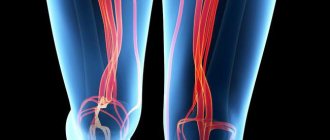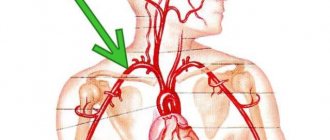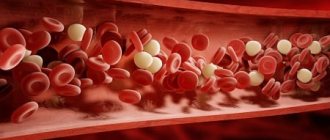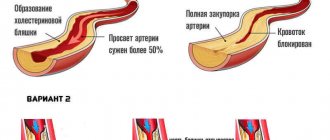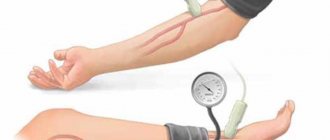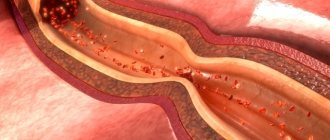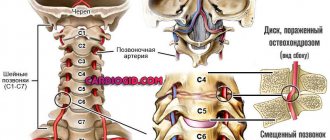Occlusion and its causes
We found that occlusion occurs due to blockage of the vessel. What factors can cause this same blockage?
The causes of the pathological process are determined by the types of damage:
- The vessel is affected by an infectious inflammatory process. As a result, it becomes clogged with purulent accumulations and blood clots. This type of occlusion of the lower extremities is called embolism.
- Blockage of a vessel by air bubbles is a serious complication if the intravenous infusion system and intravenous injection are not installed correctly. The same complication can develop as a result of severe diseases and injuries of the lungs. It's called an air embolism.
- With pathological heart diseases, arterial embolism may develop. It is characterized by blockage of a vessel with blood clots coming directly from the heart. In some cases, they form in its valves.
- Due to injuries, metabolic disorders and obesity, fat embolism can develop. In this case, the vessel is blocked by a blood clot consisting of adipose tissue.
Blockage of blood vessels can occur due to the following diseases:
- thromboembolism (more than 90% of cases of occlusion occur against its background);
- myocardial infarction;
- heart disease;
- ischemic disease;
- hypertension and arrhythmia;
- atherosclerosis;
- cardiac aneurysms;
- postoperative period on arteries;
- vasospasm;
- electrical injuries;
- leukemia;
- frostbite of the extremities.
The most common cause of occlusion of the lumen of the arteries of the legs is atherosclerosis.
The concept of occlusion (blockage) of blood vessels in the legs
Blockage of the arteries of the lower extremities leads to a cessation of oxygen and nutrients to the organs and tissues they supply. The popliteal and femoral arteries are most often affected The disease develops abruptly and unexpectedly.
The lumen of the vessel can be blocked by thrombi or emboli of various origins. The diameter of the artery, which becomes impassable, depends on their size.
In this case, tissue necrosis quickly develops in the area below the blockage of the artery.
The severity of the signs of pathology depends on the location of the occlusion and the functioning of the lateral - collateral blood flow through healthy vessels running parallel to the affected ones. They deliver nutrients and oxygen to ischemic tissues.
Blockage of the arteries is often complicated by gangrene, stroke, or heart attack, which lead the patient to disability or death.
It is impossible to understand what leg vascular occlusion is, to understand the severity of this disease, without knowing its etiology, clinical manifestations, and treatment methods. We must also take into account the importance of preventing this pathology.
More than 90 % of cases of blocked arteries in the legs have two main causes:
- Thromboembolism - blood clots form in the main vessels, are delivered by the blood flow to the arteries of the lower extremities and block them.
- Thrombosis - a blood clot as a result of atherosclerosis appears in the artery, grows and closes its lumen.
Etiology
The etiology of the remaining cases is as follows:
- accumulation of cholesterol plaques on the walls of blood vessels during atherosclerosis until it becomes blocked;
- embolism with particles of fat or foreign body, air bubbles, injection fluid;
- arterial aneurysm - their stretching and protrusion, in which blood clots and emboli quickly accumulate;
- mechanical trauma to blood vessels, compression, blocking blood flow;
- inflammatory diseases of the arteries, which are accompanied by swelling and accumulation of exudate;
- cardiac ischemia, hypertension, heart disease, myocardial infarction, diabetes mellitus contribute to the development of occlusion;
- leukemia - the lumen of the artery is blocked by growing malignant cells.
Risk factors
Vascular occlusion is a disease for the development of which the presence of risk factors . Minimizing them reduces the possibility of obstruction. They are:
- alcoholism, drug addiction, smoking;
- heredity;
- surgery on the blood vessels of the legs;
- unbalanced diet;
- pregnancy, childbirth;
- excess weight;
- sedentary lifestyle;
- gender - men are more often affected, age - more than 50 years.
The effects of underlying causes and risk factors often take a long time to accumulate.
Important! Experts note the spread of leg vascular occlusion among young people, many of whom sit in front of computers and gadget monitors. Therefore, when the first signs of occlusion occur, regardless of age category, you must immediately consult a doctor.
Types of occlusion
Depending on the location of the pathological process, the following types of blockage of the lower extremities are distinguished:
- Damage to small arteries, resulting in damage to the feet and legs. This is the most common type of occlusion.
- Obstruction of arteries of large and medium diameter. The iliac and femoral parts of the lower extremities are affected. A disease such as occlusion of the superficial femoral artery occurs.
- Often a mixed type of occlusion occurs, when both previous types exist simultaneously. For example, damage to the popliteal artery and lower leg.
Symptoms
Symptoms develop gradually and lead to the next stages of the disease.
Stage I
Characterized by pale skin and cold extremities. When walking for a long time, leg fatigue occurs in the calf muscles.
Stage II
A-there is pain of a compressive and increasing nature when walking short distances. Characteristic signs are stiffness and slight lameness.
B-pain is acute and does not allow walking long distances. The lameness is increasing.
Stage III
The pain is pronounced. Acute pain does not subside when the lower extremities are at rest.
IV stage
Violations of the integrity of the skin, expressed in trophic changes. Gangrene and ulcers form on the affected limbs.
Consequences of lower limb ischemia
Causes of the disease
Unfortunately, the causes of popliteal artery thrombosis still remain unclear. The mechanism of changes in blood composition can change under the influence of various factors. Experts argue that there is almost always a mutual influence of such factors: an increase in agents that increase blood viscosity does not cause the formation of blood clots in the absence of changes in the structure of the vascular wall.
Among the most significant provocateurs of thrombosis, phlebologists name:
- Age-related changes. The disease is more often diagnosed in patients over 40 years of age.
- Hormonal background. It has been proven that under the influence of female sex hormones the blood becomes more viscous. That is why thrombophlebitis is more often diagnosed in women over the age of 30. In men, the peak incidence occurs at 50 years of age or more, since it is at this age that the level of male hormones declines against the background of an increase in female hormones.
- Pathologies of blood vessels, most often varicose veins. This disease causes venous outflow to slow down, which can cause the blood to become thicker.
- The presence of systemic diseases and oncology. Many pathologies can provoke changes in the composition of the blood and make it more viscous.
- Physical impact on blood vessels - bruises of soft tissues, fractures of limbs, surgery, pulling the legs with excessively tight clothes or shoes.
No less harmful effects on the blood and blood vessels are caused by bad habits, drinking a small volume of fluid, pregnancy or long-term use of contraceptives, and long-term immobilization.
Thrombosis of the femoral-popliteal segment manifests itself with typical signs for this type of pathology, embodying the classic form of venous insufficiency. In this case, patients most often encounter the following manifestations of the disease:
- discomfort in the lower leg, namely in the calf muscle, developing into pain as the load on the leg increases;
- increased calf girth due to swelling;
- a feeling of heaviness and fatigue in the legs, relieved by lying down with the legs elevated;
- sharp pain on the back of the knee joint when bending the limb;
- swelling of the veins on the back of the leg and directly below the knee;
- an increase in skin temperature at the site of the thrombus.
When inflammation occurs, the patient may experience symptoms such as an increase in body temperature followed by signs of general intoxication of the body.
The phenomena listed above can be considered as the main ones when making a diagnosis, however, even severe symptoms of thrombophlebitis need confirmation. For this purpose, a number of instrumental studies are used (angiography or ultrasound angioscanning), as well as laboratory blood tests. Based on the data obtained, the doctor prescribes treatment to eliminate blood clots and prevent relapses.
Diagnostics
Diagnosis of occlusion of the arteries of the lower extremities is based on a number of the following procedures:
- Examination of the limbs by a vascular surgeon. Visually you can see dryness and thinning of the skin, swelling and swelling.
- Scanning of arteries. This method allows you to detect the site of blockage of the vessel.
- Ankle-brachial index. This is a test that evaluates blood flow in the extremities.
- MSCT angiography. It is used as an additional method when the others are not informative.
- Angiography using X-ray and contrast agent.
How to treat occlusion of the arteries of the lower extremities
Today, diseases of the cardiovascular system are not so rare. Occlusion of the arteries of the lower extremities often occurs, which is a narrowing of the lumen between the walls of the vessels. Sometimes this process contributes to complete blockage of the veins, and then the disease is very difficult to cure. Since this disease is difficult to treat, experts recommend taking regular preventive measures and immediately starting treatment when the first symptoms of such a disease appear.
Causes of pathology
Experienced doctors say that vascular occlusion of the lower extremities can occur due to blood flow disturbances. Most often, blood obstruction is fixed in the femoral artery. The disease develops gradually over a long period of time.
Typically, professionals associate it with some specific complications. An example of this would be thromboembolism. Moreover, almost 90% of all cases are associated with blood clot problems. The basis for the appearance of occlusion may be atherosclerosis and blockage of blood vessels by cholesterol plaques.
Vascular obstruction is often observed during embolism. This is the so-called blockage of blood vessels with gases and other vessels. Similar problems can arise due to incorrect placement of an IV or taking a blood test from a vein.
Often, mechanical damage to the veins can become a condition for the appearance of this disease. In this case, the gaps are closed by adipose tissue, which eventually closes the entire vessel. This condition is especially dangerous when the popliteal artery is blocked.
The inflammatory process in the body can also contribute to the appearance of occlusion.
As a result, an infection enters the body, which creates this problem in the body.
Lower extremity occlusion can occur due to severe frostbite of the lower extremities, abnormal blood pressure readings, and even complications after surgery.
What symptoms accompany the disease at different stages?
The symptom of occlusion depends, first of all, on the stage of the disease that is observed in the patient. Experts in the field of medicine distinguish 4 main stages of occlusion of the lower extremities.
- At the first stage, a person may feel slight fatigue, which occurs as a result of prolonged walking. After serious physical exertion, such patients usually have lighter skin, and sometimes even too white. It is this symptom that should prompt a person to consult a specialist, especially if this phenomenon occurs with a certain regularity.
- At the second stage, the legs begin to hurt severely, even if the person does not put any weight on the limbs. Sometimes it gets to the point where a slight lameness develops. This is also a sign that it is time to seek advice from a specialist.
- At the next stage, pain is observed even when the person is at rest. They become so unbearable that some patients resort to self-medication.
- At the last stage, vascular disease is visible to the naked eye. Sores appear on the skin of the legs, which constantly grow in size and hurt unbearably. In particularly advanced conditions, it sometimes leads to the appearance of gangrene.
At all stages of the disease it has its own visual manifestations. For example, blue discoloration of the skin or darkening of blood vessels.
How is the presence of occlusion determined?
If a patient feels severe pain when walking and not only notices changes in skin tone after exercise, he should urgently seek help from a specialist who treats cardiovascular diseases. Only a true professional can confirm or deny that this is an occlusion of the lower extremities, and the person needs immediate treatment. After an examination, the doctor will definitely prescribe a suitable treatment program that will help get rid of the disease.
Diagnostics involves several studies by a specialist. As soon as a person contacts the appropriate doctor, he immediately conducts a visual examination. It involves assessing the shade of the lower extremities, feeling them, etc.
If the doctor determines that this may indeed be an occlusion, the patient is prescribed a scan of the arteries of the lower extremities, treatment of which will still be prescribed, regardless of the disease. During this procedure, the specialist must determine the specific location of the blockage.
After this, the doctor must calculate the so-called ankle-brachial index. They will allow you to make more accurate conclusions about the speed of blood flow and, accordingly, prescribe the correct treatment.
The easiest way to identify the problem is MSCT angiography. This procedure allows you to assess the condition of the blood vessels and its deviation from the norm.
The set of diagnostic procedures depends on the stage of the disease, the speed of its progress and the professionalism of your attending physician.
Treatment
Similar article: Obliterating endarteritis of the vessels of the lower extremities
Treatment is carried out by a vascular surgeon and is carried out depending on the stage of the disease.
Stage I of the disease is treated conservatively. For this, the following series of drugs are used:
- thrombolytics;
- antispasmodics;
- fibrinolytic drugs.
Physiotherapeutic procedures are often prescribed, which have a positive effect. These are magnetic therapy, barotherapy and others. Plasmapheresis has also proven effective.
Stage II requires surgical intervention, which includes:
- thrombectomy (excision of a blood clot);
- bypass;
- vessel prosthetics.
These manipulations allow you to restore normal blood flow in the lower extremities.
In case of severe occlusion of the great vessels, stenting of the arteries is performed
Stage III includes emergency surgical intervention, consisting of:
- thrombectomy;
- bypass;
- fasciotomy;
- necrectomy;
- sparing amputation.
Stage IV involves exclusively amputation of the limb, since intervention at the vascular level can lead to complications and death.
Prevention
Prevention includes the following set of measures:
- Monitoring blood pressure levels. Timely treatment of hypertension.
- The diet should exclude fatty and fried foods and be enriched with plant fiber.
- Moderate physical activity, reducing excess body weight.
- Smoking and drinking alcoholic beverages are prohibited.
- Minimize stressful situations.
At the slightest sign of occlusion of the lower extremities, it is necessary to be examined by a vascular surgeon. Serious consequences can be avoided if you contact a specialist in a timely manner.
